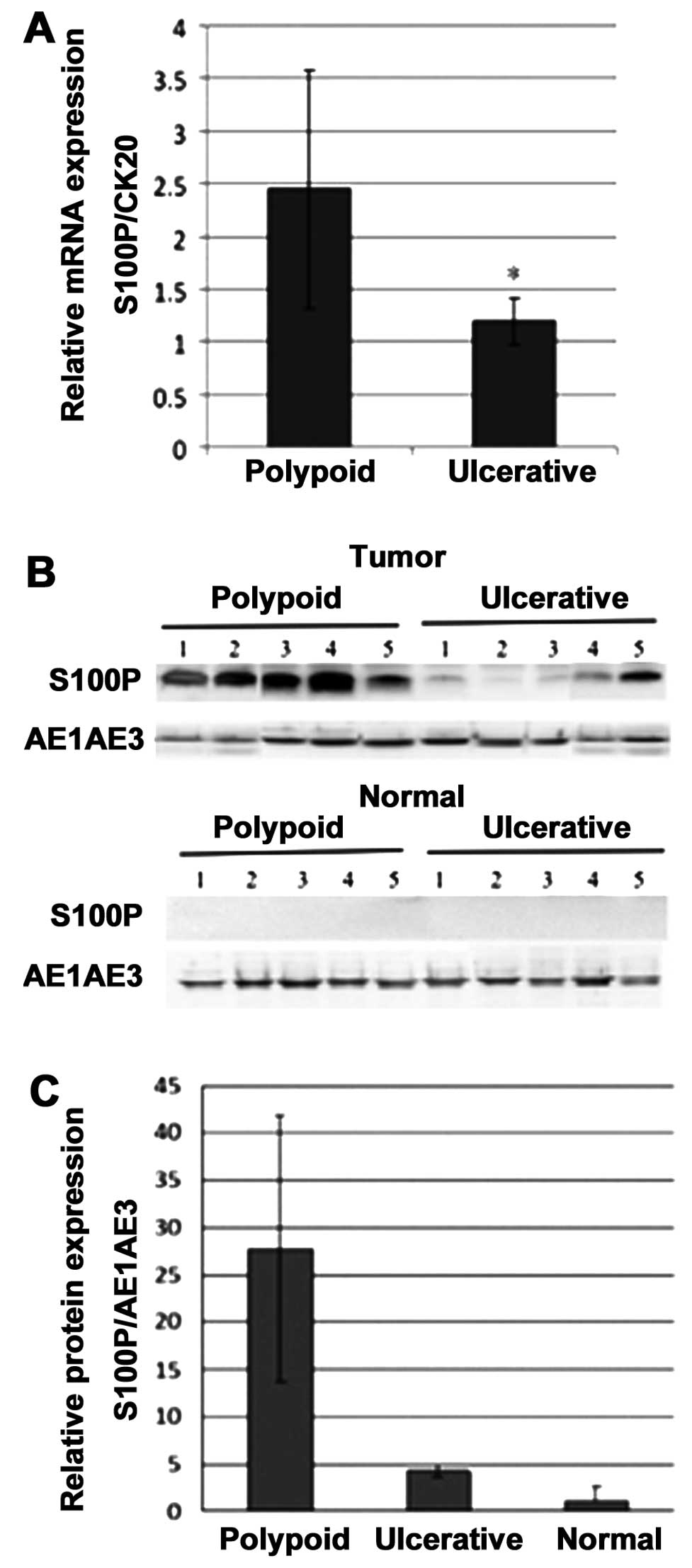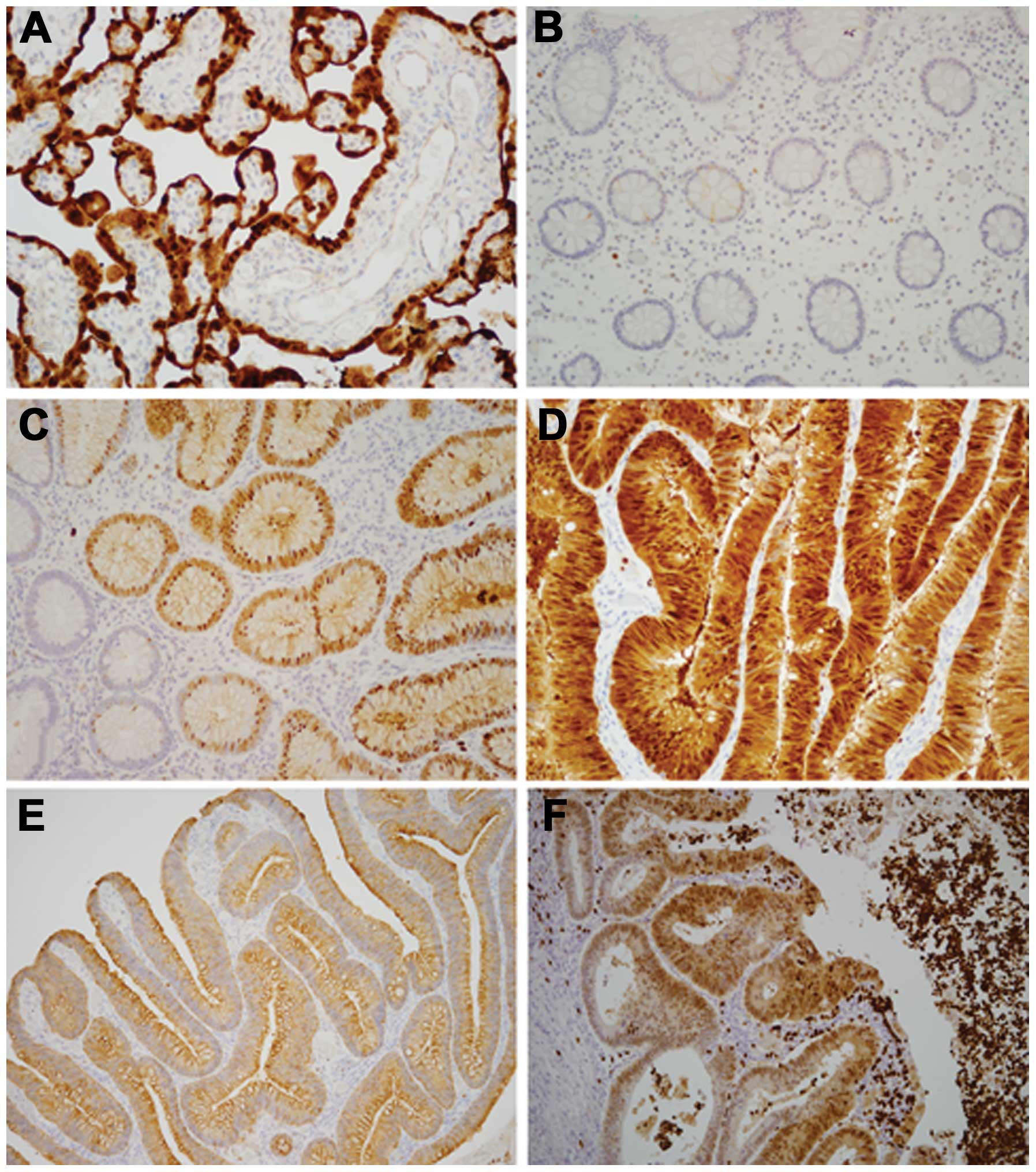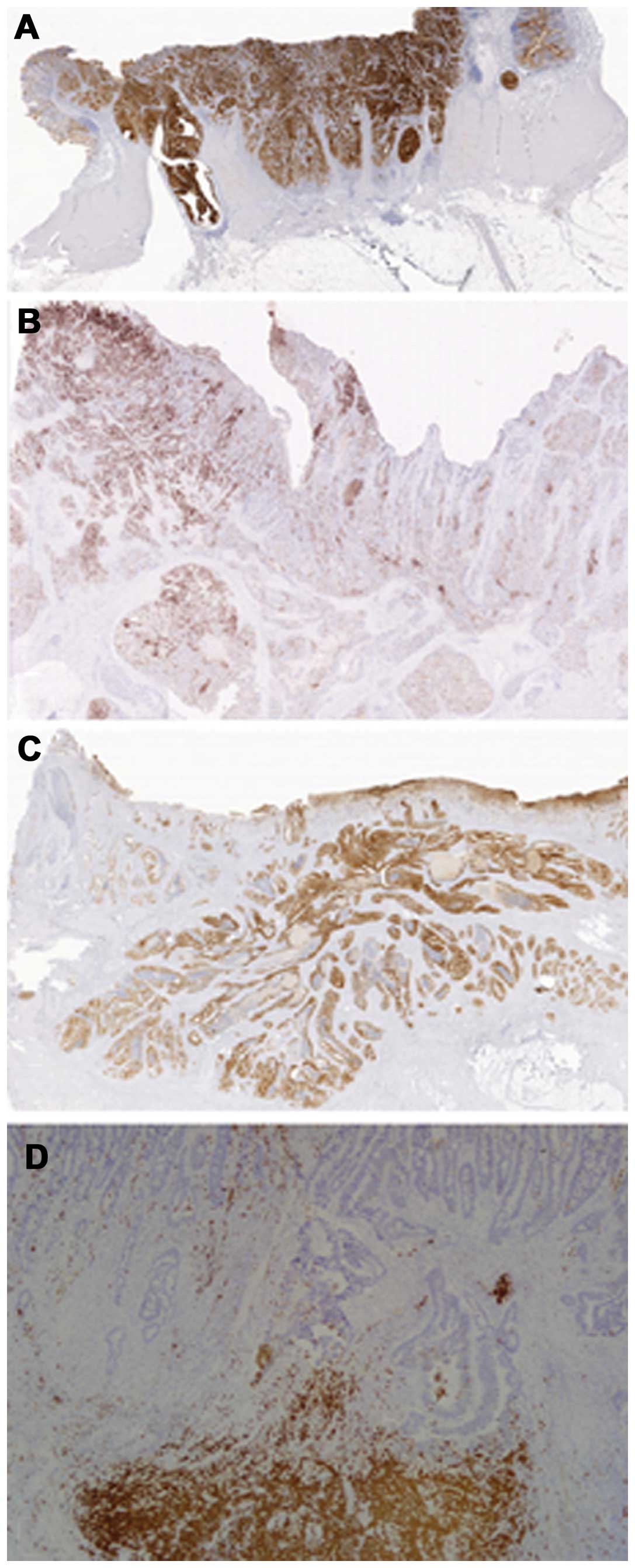|
1
|
Fearon ER and Vogelstein B: A genetic
model for colorectal tumorigenesis. Cell. 61:759–767. 1990.
View Article : Google Scholar : PubMed/NCBI
|
|
2
|
Jass JR: Classification of colorectal
cancer based on correlation of clinical, morphological and
molecular features. Histopathology. 50:113–130. 2007. View Article : Google Scholar : PubMed/NCBI
|
|
3
|
Shimoda T, Ikegami M, Fujisaki J, Matsui
T, Aizawa S and Ishikawa E: Early colorectal carcinoma with special
reference to its development de novo. Cancer. 64:1138–1146. 1989.
View Article : Google Scholar : PubMed/NCBI
|
|
4
|
Jass JR, Constable L, Sutherland R,
Winterford C, Walsh MD, Young J and Leggett BA: Adenocarcinoma of
colon differentiating as dome epithelium of gut-associated lymphoid
tissue. Histopathology. 36:116–120. 2000. View Article : Google Scholar : PubMed/NCBI
|
|
5
|
Sedivy R, Wolf B, Kalipciyan M, Steger GG,
Karner-Hanusch J and Mader RM: Genetic analysis of multiple
synchronous lesions of the colon adenoma-carcinoma sequence. Br J
Cancer. 82:1276–1282. 2000.
|
|
6
|
Yashiro M, Carethers JM, Laghi L, et al:
Genetic pathways in the evolution of morphologically distinct
colorectal neoplasms. Cancer Res. 61:2676–2683. 2001.PubMed/NCBI
|
|
7
|
Kaneko K, Fujii T, Kato S, et al: Growth
patterns and genetic changes of colorectal carcinoma. Jpn J Clin
Oncol. 28:196–201. 1998. View Article : Google Scholar : PubMed/NCBI
|
|
8
|
Uronis JM and Threadgill DW: Murine models
of colorectal cancer. Mamm Genome. 20:261–268. 2009. View Article : Google Scholar : PubMed/NCBI
|
|
9
|
Richter H, Slezak P, Walch A, et al:
Distinct chromosomal imbalances in nonpolypoid and polypoid
colorectal adenomas indicate different genetic pathways in the
development of colorectal neoplasms. Am J Pathol. 163:287–294.
2003. View Article : Google Scholar : PubMed/NCBI
|
|
10
|
van Wyk R, Slezak P, Hayes VM, et al:
Somatic mutations of the APC, KRAS, and TP53 genes in nonpolypoid
colorectal adenomas. Genes Chromosomes Cancer. 27:202–208. 2000.
View Article : Google Scholar
|
|
11
|
Yamagata S, Muto T, Uchida Y, et al: Lower
incidence of K-ras codon 12 mutation in flat colorectal adenomas
than in polypoid adenomas. Jpn J Cancer Res. 85:147–151. 1994.
View Article : Google Scholar : PubMed/NCBI
|
|
12
|
Chiang JM, Chou YH and Chou TB: K-ras
codon 12 mutation determines the polypoid growth of colorectral
cancer. Cancer Res. 58:3289–3293. 1998.PubMed/NCBI
|
|
13
|
Yamagata S, Muto T, Uchida Y, et al:
Polypoid growth and K-ras codon 12 mutation in colorectal cancer.
Cancer. 75:953–957. 1995. View Article : Google Scholar : PubMed/NCBI
|
|
14
|
Aust DE, Terdiman JP, Willenbucher RF, et
al: Altered distribution of beta-catenin, and its binding proteins
E-cadherin and APC, in ulcerative colitis-related colorectal
cancers. Mod Pathol. 14:29–39. 2001. View Article : Google Scholar : PubMed/NCBI
|
|
15
|
Chiang JM, Chou YH, Chen TC, Ng KF and Lin
JL: Nuclear beta-catenin expression is closely related to
ulcerative growth of colorectal carcinoma. Br J Cancer.
86:1124–1129. 2002. View Article : Google Scholar : PubMed/NCBI
|
|
16
|
Trevino V, Falciani F and Barrera-Saldaña
HA: DNA microarrays: a powerful genomic tool for biomedical and
clinical research. Mol Med. 13:527–541. 2007. View Article : Google Scholar : PubMed/NCBI
|
|
17
|
Becker T, Gerke V, Kube E and Weber K:
S100P, a novel Ca2+-binding protein in human placenta.
cDNA cloing, recombinant protein expression and Ca2+
binding properties. Eur J Biochem. 2007.541–547. 1992.
|
|
18
|
Wang TH, Lee YS, Chen ES, et al:
Establishment of cDNA microarray analysis at the Genomic Medicine
Research Core Laboratory (GMRCL) of Chang Gung Memorial Hospital.
Chang Gung Med J. 27:243–260. 2004.PubMed/NCBI
|
|
19
|
Schneider CA, Rasband WS and Eliceiri KW:
NIH Image to ImageJ: 25 years of image analysis. Nat Methods.
9:671–675. 2012. View Article : Google Scholar : PubMed/NCBI
|
|
20
|
Herman JG, Graff JR, Myohanen S, Nelkin BD
and Baylin SB: Methylation-specific PCR: a novel PCR assay for
methylation status of CpG islands. Proc Natl Acad Sci USA.
93:9821–9826. 1996. View Article : Google Scholar : PubMed/NCBI
|
|
21
|
Bird A: DNA methylation patterns and
epigenetic memory. Genes Dev. 16:6–21. 2002. View Article : Google Scholar : PubMed/NCBI
|
|
22
|
Sato N, Fukushima N, Matsubayashi H and
Goggins M: Identification of maspin and S100P as novel
hypomethylation targets in pancreatic cancer using global gene
expression profiling. Oncogene. 23:1531–1538. 2004. View Article : Google Scholar : PubMed/NCBI
|
|
23
|
Chen JR, Chiang JM, Changchien CR, Chen
JS, Tang RP and Wang JY: Mismatch repair protein expression in
Amsterdam II criteria-positive patients in Taiwan. Br J Surg.
95:102–110. 2008. View
Article : Google Scholar
|
|
24
|
Parkkila S, Pan PW, Ward A, et al: The
calcium-binding protein S100P in normal and malignant human
tissues. BMC Clin Pathol. 8(2): 2008
|
|
25
|
Lam FF, Jankova L, Dent OF, et al:
Identification of distinctive protein expression patterns in
colorectal adenoma. Proteomics. Clin Appl. 4:60–70. 2010.
View Article : Google Scholar
|
|
26
|
Mousses S, Bubendorf L, Wagner U, et al:
Clinical validation of candidate genes associated with prostate
cancer progression in the CWR22 model system using tissue
microarrays. Cancer Res. 62:1256–1260. 2002.PubMed/NCBI
|
|
27
|
Birkenkamp-Demtroder K, Olesen SH,
Sorensen FB, et al: Differential gene expression in colon cancer of
the caecum versus the sigmoid and rectosigmoid. Gut. 54:374–384.
2005. View Article : Google Scholar : PubMed/NCBI
|
|
28
|
Wang G, Platt-Higgins A, Carroll J, et al:
Induction of metastasis by S100P in a rat mammary model and its
association with poor survival of breast cancer patients. Cancer
Res. 66:1199–1207. 2006. View Article : Google Scholar : PubMed/NCBI
|
|
29
|
Crnogorac-Jurcevic T, Missiaglia E,
Blaveri E, et al: Molecular alterations in pancreatic carcinoma:
expression profiling shows that dysregulated expression of S100
genes is highly prevalent. J Pathol. 201:63–74. 2003. View Article : Google Scholar : PubMed/NCBI
|
|
30
|
Rehbein G, Simm A, Hofmann HS, Silber RE
and Bartling B: Molecular regulation of S100P in human lung
adenocarcinomas. Int J Mol Med. 22:69–77. 2008.PubMed/NCBI
|
|
31
|
Guerreiro Da, Silva ID, Hu YF, Russo IH,
et al: S100P calcium-binding protein overexpression is associated
with immortalization of human breast epithelial cells in vitro and
early stages of breast cancer development in vivo. Int J Oncol.
16:231–240. 2000.
|
|
32
|
Kita H, Hikichi Y, Hikami K, et al:
Differential gene expression between flat adenoma and normal mucosa
in the colon in a microarray analysis. J Gastroenterol.
41:1053–1063. 2006. View Article : Google Scholar : PubMed/NCBI
|
|
33
|
Fuentes MK, Nigavekar SS, Arumugam T, et
al: RAGE activation by S100P in colon cancer stimulates growth,
migration, and cell signaling pathways. Dis Colon Rectum.
50:1230–1240. 2007. View Article : Google Scholar : PubMed/NCBI
|
|
34
|
Jiang L, Lai YK, Zhang J, et al: Targeting
S100P inhibits colon cancer growth and metastasis by
Lentivirus-mediated RNA interference and proteomic analysis. Mol
Med. 17:709–716. 2011. View Article : Google Scholar : PubMed/NCBI
|
|
35
|
Lao VV and Grady WM: Epigenetics and
colorectal cancer. Nat Rev Gastroenterol Hepatol. 8:686–700. 2011.
View Article : Google Scholar : PubMed/NCBI
|
|
36
|
Wang Q, Williamson M, Bott S, et al:
Hypomethylation of WNT5A, CRIP1 and S100P in prostate cancer.
Oncogene. 26:6560–6565. 2007. View Article : Google Scholar : PubMed/NCBI
|
|
37
|
Chandramouli A, Mercado-Pimentel ME,
Hutchinson A, et al: The induction of S100p expression by the
Prostaglandin E2(PGE2)/EP4 receptor signaling
pathway in colon cancer cells. Cancer Biol Ther. 10:1056–1066.
2010. View Article : Google Scholar : PubMed/NCBI
|
|
38
|
Gibadulinova A, Tothova V, Pastorek J and
Pastorekova S: Transcriptional regulation and functional
implication of S100P in cancer. Amino Acids. 41:885–892. 2011.
View Article : Google Scholar
|
|
39
|
Maletzki C, Bodammer P, Breitruck A and
Kerkhoff C: S100 proteins as diagnostic and prognostic markers in
colorectal and hepatocellular carcinoma. Hepat Mon.
12:e72402012.PubMed/NCBI
|
|
40
|
Arumugam T, Simeone DM, Schmidt AM and
Logsdon CD: S100P stimulates cell proliferation and survival via
receptor for activated glycation end products (RAGE). J Biol Chem.
279:5059–5065. 2004. View Article : Google Scholar
|
|
41
|
Zhuang L, Peng JB, Tou L, et al:
Calcium-selective ion channel, CaT1, is apically localized in
gastrointestinal tract epithelia and is aberrantly expressed in
human malignancies. Lab Invest. 82:1755–1764. 2002. View Article : Google Scholar : PubMed/NCBI
|
|
42
|
Walther A, Johnstone E, Swanton C, Midgley
R, Tomlinson I and Kerr D: Genetic prognostic and predictive
markers in colorectal cancer. Nat Rev Cancer. 9:489–499. 2009.
View Article : Google Scholar : PubMed/NCBI
|















